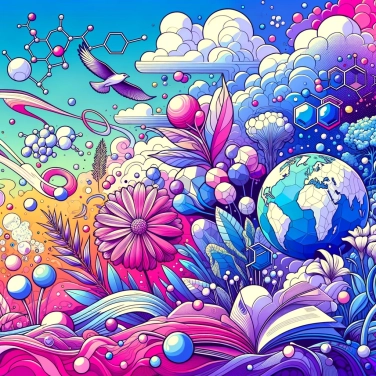Clouds remain suspended because the water droplets or ice crystals that compose them are extremely light and are carried upward by the ascending air currents.

A cloud, despite its massive and dense appearance, actually has an extremely low density. It mainly consists of air containing countless tiny water droplets or microcrystals of ice suspended in it. Each of these droplets is so small and light that it "floats" easily due to atmospheric currents. Ultimately, a cloud is primarily made up of humid air. This mixture of air and water is generally less dense than the cooler, dry air below, which explains why, despite their impressive overall weight (sometimes several tons!), clouds don't just fall on our heads.
Despite their weight, clouds do not fall because updrafts, that is, warm air flows rising from the ground to the sky, constantly push the droplets upward. Since warm air is lighter than cold air, this upward movement acts like a real conveyor belt, supporting the clouds well above our heads. As long as these currents remain strong enough, they easily counteract the gravity that would pull the droplets down to the ground. It's a bit like juggling: as long as you keep the rhythm of sending the balls up in the air, they don’t fall. As soon as these currents weaken, the clouds begin to sag, which can lead to rain or even sudden showers if the current stops abruptly.
The clouds stay up there mainly thanks to the heat from the sun: the rays constantly warm the ground and the air below. This warm air, which is necessarily lighter than cold air, tends to rise naturally: we refer to this as thermal updrafts. These thermal phenomena act continuously, always supplying the clouds with rising warm air. At the same time, the water droplets in the cloud are extremely light, tiny little spheres that fall very slowly, effectively slowed down by air resistance. This friction significantly slows the descent of the tiny droplets, even giving them enough time to evaporate before reaching the ground. As long as the air beneath the cloud remains warm and dynamic, these effects balance each other effectively, allowing the cloud to float peacefully up there without falling freely towards our heads.
Lighter clouds contain very fine droplets of water, which easily remain suspended due to their lightness and upward currents. In contrast, in heavier clouds, these small droplets merge into larger droplets, which are heavier and eventually fall due to gravity. In other words, when the droplets become too large to be supported by the upward currents and warm air, they precipitate to the ground in the form of rain. It is this droplet size and their ability to merge that makes all the difference between a cloud drifting peacefully above our heads and another that suddenly pours a heavy shower on our umbrellas.
For the droplets to finally fall, they must first gain sufficient weight. In a cloud, many tiny droplets float peacefully, but as they grow larger, they gain mass. Once they exceed a certain size, gravity takes over from the upward air currents. At this point, they begin to fall. Another necessary factor is a temperature low enough to condense water vapor and allow the droplets to grow heavy enough. The presence of fine particles, such as small dust particles naturally found in the air, is also crucial — it is around them that water seems to like to cluster to form larger droplets. Finally, when the humidity of the cloud is sufficient and the upward currents weaken or completely disappear, the droplets have nothing holding them back and off they go to the ground.
Specific clouds known as cumulus congestus can rapidly develop into cumulonimbus, the clouds responsible for thunderstorms and storms, due to very strong updrafts capable of suspending large amounts of water, and even hail!
The droplets that make up clouds are so small that they need to unite with each other to become heavy enough to form raindrops. Without repeated collisions and merging, these tiny droplets could remain suspended almost indefinitely.
Fog and clouds are actually very similar; the main difference is simply their altitude: fog is nothing more than a cloud in direct contact with the Earth's surface!
If a cloud looks particularly dark or gray, it's not that it contains 'dirty water', but simply that it is so thick and dense that sunlight has difficulty passing through it. The denser it is, the more opaque it will be to visible light.
Yes, clouds are actually made up of tiny suspended water droplets. Thus, when you are on a high enough mountain, you are literally immersed in fog, which is nothing more than a cloud seen from the inside.
A cloud appears motionless when it is located in a region of the atmosphere where the speeds and directions of air currents are balanced. Although it seems static, it continues to undergo internal movements while remaining stable in its position.
Airplanes are specifically designed to pass through clouds with minimal disturbance. Even when a cloud is dense, the droplets or ice crystals that make it up are small enough not to damage the aircraft. Specific equipment ensures safe navigation even under these conditions.
Sure! Here’s the translation: "Yes, when certain atmospheric conditions occur, droplets can freeze, forming ice crystals that fall as snow or hail when their weight exceeds the upward thrust."
Dark clouds contain large amounts of condensed water. However, for rain to fall, the droplets must reach a sufficiently large size. Without enough collisions between droplets or a lack of favorable conditions, the cloud will remain dark without precipitating immediately.

0% of respondents passed this quiz completely!
Question 1/5